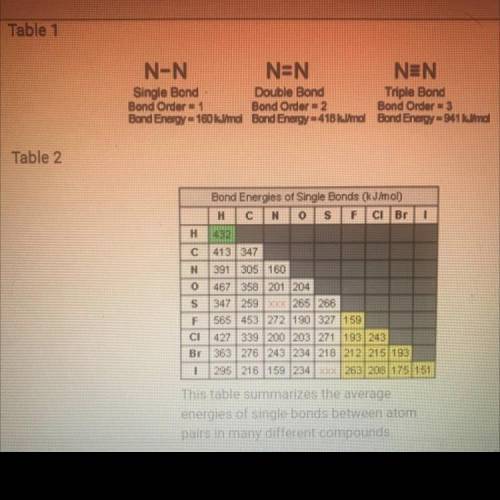
Chemistry, 08.12.2020 04:00 freshysans4
EASY QUESTIONS THERE ARE JUST A LOT Please answer these. The tables needed for question 7 are in the picture. I got rid of some of the questions that you wouldn’t be able to answer without doing the lesson
Question 1: Electron Notation Example (2 points)
a. Give the electron configuration of vanadium (V), atomic number 23. (0.5 points)
b. Give the noble gas configuration of vanadium (V), atomic number 23. (0.5 points)
c. List the energy levels for the orbital configuration of vanadium (V), atomic number 23. (1 point)
Question 3: Trends on the Periodic Table (2 points)
a. How does the atomic radius change going down and across the periodic table? (0.5 points)
b. How does first ionization energy change going down and across the periodic table? (0.5 points)
c. How does electronegativity change going down and across the periodic table? (0.5 points)
d. How does the radius of a positive and negative ion compare to a neutral atom? (0.5 points)
Question 4: Chemical Bonds (1 point)
Match each chemical bond to its correct description. (1 point)
A. Ionic bond ___ Sharing of electrons
B. Covalent bond ___ Freely moving electrons
C. Metallic bond ___ Transfer of electrons
Question 5: Intermolecular Forces (3 points)
a. Describe the dipole-dipole force. (1 point)
b. Describe hydrogen bonding. (1 point)
c. Describe the Van der Waals forces. (1 point)
Question 6: Intermolecular Forces and You (2 points)
Imagine you need to take a medicine that the doctor has prescribed for you. Explain why scientists who developed that medicine would need to know whether or not the compound in that medicine is polar. How might a polar medicine behave differently within your body than a nonpolar medicine would? Answer in 1 to 2 paragraphs.
Question 7: Energy in Bonds (9 points)
Use these tables for reference for all parts of this question.
This table summarizes the average energies of single bonds between atom pairs in many different compounds.
a. According to Table 2, which is the strongest bond? Which is the weakest bond? Based on what you know about the atomic radii and electronegativity of the elements involved in the bonds, why do you think these two have the most extreme bond-energy values? (3 points)
b. How are the bond energies of each bond listed in Table 2 determined? (1 point)
c. Why do you think there aren't bond energy values given in Table 2 for N–S and S–I? (1 point)
d. Based on Tables 1 and 2, how would you describe the trend in bond strength of single, double, and triple bonds? (1 point)
e. Based on Table 2, how would you describe the trend in the strength of bonds formed by the elements carbon, nitrogen, and oxygen? Would you describe this trend as a periodic trend? Why or why not? (3 points)
Question 8: Causes of Molecular Shape (3 points)
a. What is the VSEPR theory? (1 point)
b. How does electron repulsion determine molecular shape? (1 point)
c. How do lone electron pairs affect molecular shape? (1 point)
Question 10: Lewis Structure (3 points)
a. Draw the Lewis structure for the Se and 2 H atoms. (1 point)
b. Draw the Lewis structure for the SeH2 molecule. (1 point)
c. What shape would SeH2 have? Draw the molecule. (1 point)
Question 11: Ionic and Covalent Compounds (5 points)
Identify each of the following as a covalent compound or ionic compound. Then provide either the formula for compounds identified by name or the name for those identified by formula. (1 point each)
a. Li2O:
b. Dinitrogen trioxide:
c. PCl3:
d. Manganese(III) oxide:
e. Calcium bromide:


Answers: 3
Another question on Chemistry

Chemistry, 21.06.2019 18:30
Asample of the male sex hormone testosterone, c19h28o2, contains 3.88×10^21 atoms of hydrogen.(a) how many atoms of carbon does it contain? (b) how many molecules of testosterone does it contain? (c) how many moles of testosterone does it contain? (d) what is the mass of this sample in grams?
Answers: 1

Chemistry, 23.06.2019 00:30
Nuclear decay is the spontaneous decay of one element into a. an x-ray b. a ray of light c. another element
Answers: 1

Chemistry, 23.06.2019 04:30
Two liquids are poured into a beaker. after a few seconds, the beaker becomes warm. which of the following best describes this reaction? a. an exothermic reaction b. a decomposition reaction c. an endothermic reaction d. a single-displacement reaction
Answers: 1

Chemistry, 23.06.2019 08:00
Drag each pressure unit with the corresponding number to describe standard atmospheric pressure
Answers: 1
You know the right answer?
EASY QUESTIONS THERE ARE JUST A LOT Please answer these. The tables needed for question 7 are in the...
Questions

Mathematics, 28.07.2019 19:00

History, 28.07.2019 19:00



Mathematics, 28.07.2019 19:00



Mathematics, 28.07.2019 19:00


Mathematics, 28.07.2019 19:00

Social Studies, 28.07.2019 19:00


Chemistry, 28.07.2019 19:00



Mathematics, 28.07.2019 19:00

Mathematics, 28.07.2019 19:00


Social Studies, 28.07.2019 19:00



